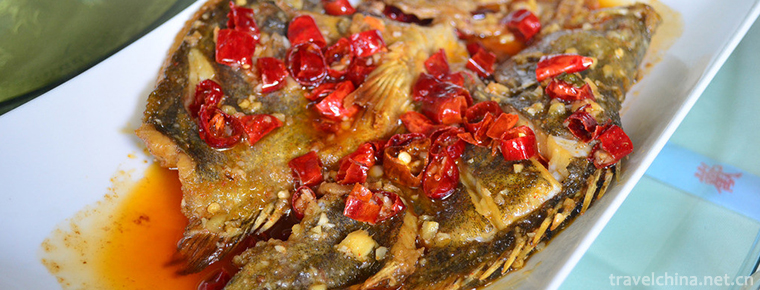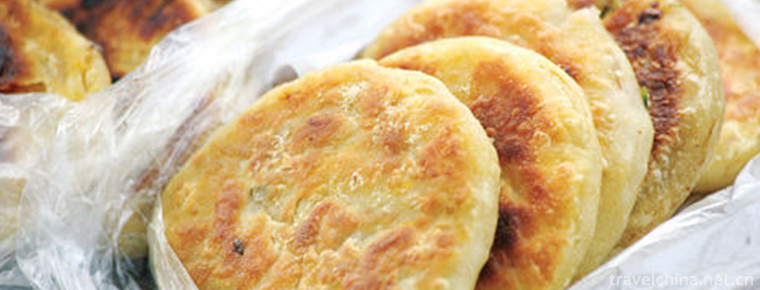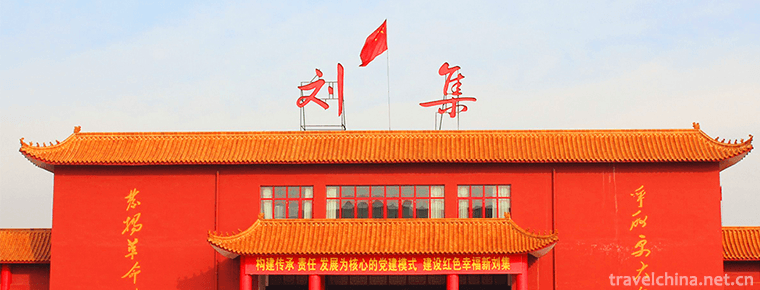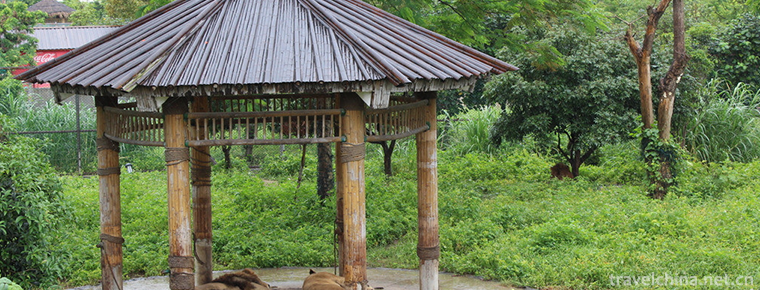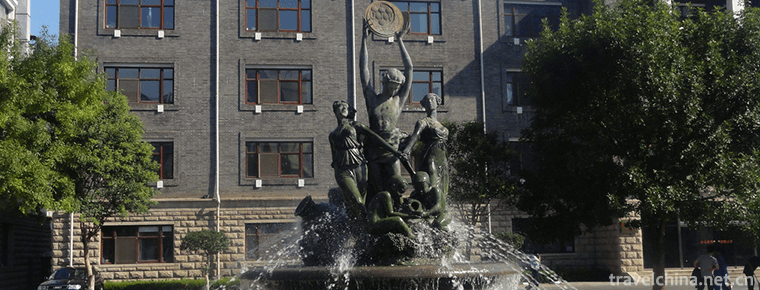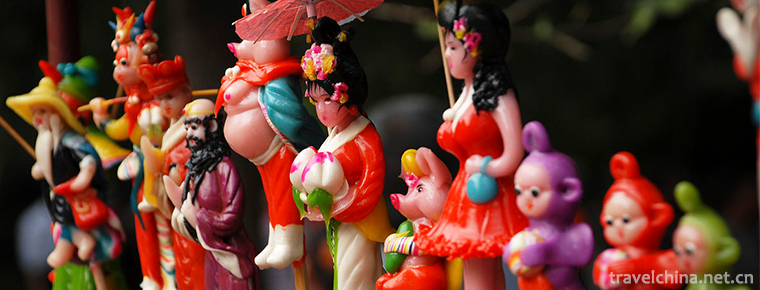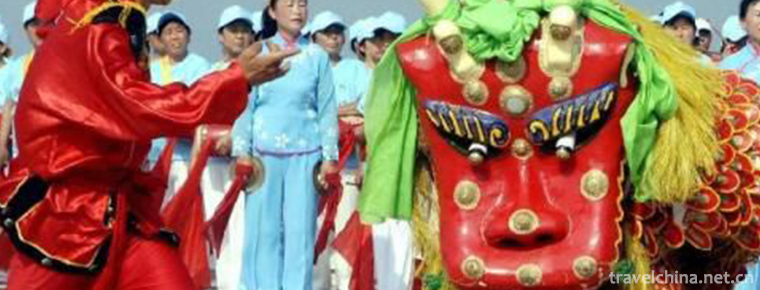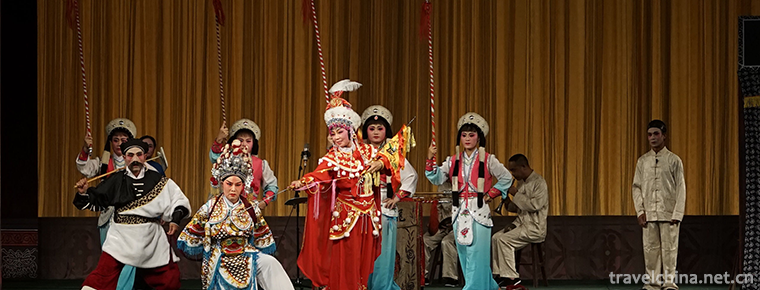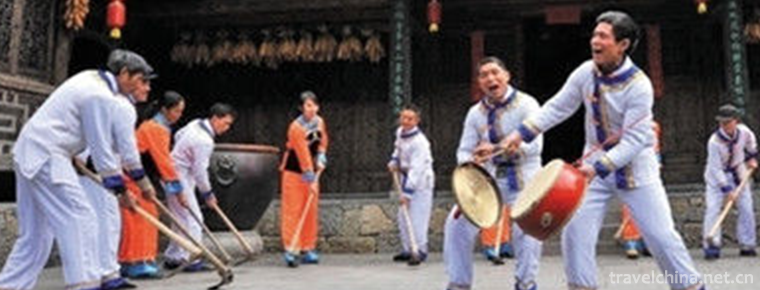Li nationality costumes
Li nationality costumes
Li costumes are mainly made of island cotton, hemp, kapok, bark fiber and silk. In ancient times, some places also used the bark of twig or bloody throat trees as clothing materials. This kind of dress material is made by cutting down the bark from the hill, removing the outer layer of skin residue by beating, leaving the fiber layer, and then soaking and drying with purple cabbage (ash burned from the shell).
Li men usually wear a pair of collarless jacket and trousers, and tie their headscarves to insert pheasant feathers. Women wear black round-collar headdress with many ornaments. The neckline is connected with white and green beads into three sets of edges. The cuffs and hems are decorated with patterns. The front and back are strung with beads in a color pattern. Wear a tight miniskirt underneath. Some wear black and blue flat-collar jackets, white embroidered cuffs, a stripe pattern on the back, a colorful flower dress with folds at the front, silver chains at the head, silver necklaces at the neck, pearl bells at the chest, and silver rings at the hands. The head is tied with a black cloth scarf.
The Li costumes declared by Hainan Jinxiu Zhibei Co., Ltd. on June 14, 2008 were listed in the second batch of national intangible cultural heritage list with the approval of the State Council. (Category: Folklore; Number: _-111)
Historical evolution
Overview
The traditional costumes of Li nationality are brilliant and colorful, and their styles and patterns have local characteristics.
Ancient
Historically, Li women in Hainan Island were skilled in textiles, dyeing and embroidery. They used island cotton, kapok, bark fiber and silk to sew clothes.
Shangshu Yugong records that "island Yihua clothes, pole weaving shellfish" refers to the situation of textiles. The Han Dynasty has "wide distribution", the Tang Dynasty has "Jibeibu", "Panban cloth", "food list" (tablecloth), to the Song Dynasty has "blue and white cloth" and so on. In Book of the Later Han Dynasty, Volume 86, Biographies of Nanman, it is recorded that at the end of Emperor Wu, Sun Xing, a member of the Zhuya Taishou Association, spread his works in a wide range, and was unable to serve, so he attacked the county and killed the fortune.
” In the middle of Tang Dynasty, Li women woven quilts, tablecloths and dish patches with "Jibei" (wild kapok) and were listed as tributes of the court. After the Song Dynasty, the cotton textile skills of the Li nationality became more superb. The women of the Li nationality weaved delicate cotton fabrics such as "Li Jin", "Li Dan", "Li Curtain" and "Li Mantle", which were loved by the people of the Central Plains. There used to be "bark cloth" costumes in Li society. This dress material is made by cutting down the bark of the toon tree or the bloody throat tree on the hill, beating off the outer skin slag, leaving the fiber layer, and then soaking and drying with lime (ash burned from the shell). Li ancestors used this bark fiber to sew clothes, quilts, hats and so on.
Before the founding of the People's Republic of China, most Li costumes were self-spun, self-woven, self-dyed and self-sewn. Their dyes were made of mountain plants, supplemented by mineral dyes. The music history of the Song Dynasty, Taiping Huanyu Ji, Fan Chengda's Guihai Yuheng Zhi, Zhao Rushi's Zhufan Zhi and Zhou Qufei's Lingwai Dai Answer, all have records about the material of Li brocade. For example, "Guihai Yu Heng Zhi" Volume 15: "When the curtain rises in Lidong, Hainan, Li people get Chinese brocade collection, take out color silk, and weave kapok into a single scene with four pieces of kapok." In addition, Volume 6 of Ling Wai Dai Dai Answer reads: "Hainan knitted (Gibeb) is very tasteful! Extremely wide... Between five picks, different lines are shining! ______________ The "Li brocade", "Li dan" and "Li curtain" weaved by the Li people in Hainan are very popular in the Central Plains because of their bright colors, beautiful appearance and applicability.
There are many records about Li costumes in ancient books, such as Han Shu Volume 28 Geographic Records: "In the first year of Emperor Wu Yuanfeng, people slightly thought that Daner and Zhuya prefectures were all clothed, such as single quilt, running through the central government. Shi Gu said,'Write from the beginning to the end'. The women of Li nationality in Mobil dialect have traditional valerian dyeing technology. What Su Shi said in The Story of Junling King's Temple is "weaving flowers" referring to the Li nationality in Mobil dialect. This valerian dyeing method is to tie the pattern on the warp line, then dye, and then weave clothes.
In the course of frequent exchanges with various nationalities on the island, some changes have taken place in the costumes of the Li nationality. The most obvious one is to change the collarless straight jacket and through jacket into digging collar, or to change the straight body, straight seam and straight sleeve to make the waist and cuff seam (fold), or to change the buttonless to decorative button, and later to Pipa button, and finally to change the skirt to biased. The Li people in the Sai dialect, except those in Zuguan and Qunying areas of Lingshui Li Autonomous County, wear flower pots (commonly known as "silk pots"), the rest are embroidered on the skirt tail and waist, and then the jacket is decorated with brightly colored lace. The tube skirts are mostly laced with plaid patterns, and finally only wear blue dresses, black skirts or plain garments without flower patterns.
modern
After the liberation of Hainan in 1950, the costumes of Li nationality changed greatly. According to the social survey data of Li nationality in 1950s, the younger generation in the countryside at that time had generally accepted the Chinese dress, and the older men (over 40 years old) still had their own national coat, but they had changed to wear Chinese trousers or shorts instead of "eaves" (skirts with a piece of cloth hanging from front to back) and "egg wrapping cloth". Women's clothing has been changed from purchased cloth to blouses in terms of material. Dresses are still self-woven. Many people also wear all kinds of shirts and pants they buy. Only middle-aged and old women in remote areas still wear Li costumes. Since the 1980s, few people in Li society have worn ethnic costumes, and young girls in villages are not keen on brocade making ethnic costumes.
Li costumes retain strong national customs and costume characteristics. By 1990, although young men and women of Li nationality had changed into Han clothes in many places, they still wore traditional clothes on marriage, funeral, religious activities and festival days.
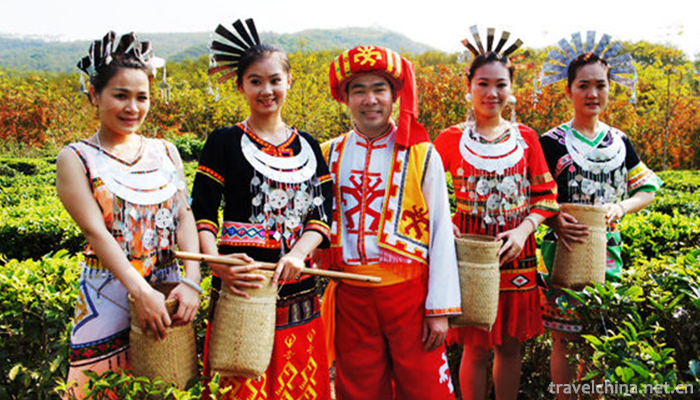
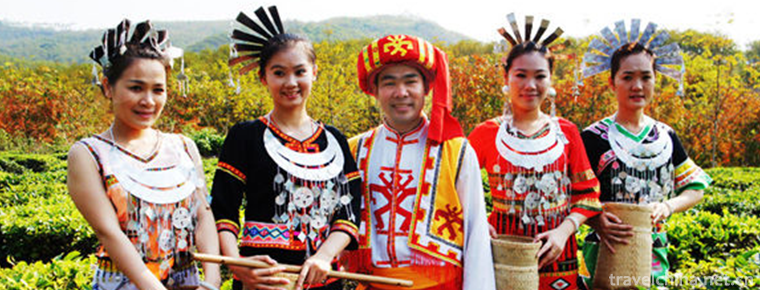
Li nationality costumes
-
Stinky mandarin fishMarinate mandarin fish
Stinky eel, also known as Stinky Osmanthus, Barrel Fresh Fish, Barrel Fresh Fish, Pickled Fresh Fish, is a traditional Huizhou dish, one of the representatives of Huizhou cuisine.
Views: 297 Time 2018-11-02 -
Huizhou cake
Huizhou cake, originally named "jujube mud crisp baked bread", is a traditional feature in Huizhou area, Anhui Province.
Views: 248 Time 2018-11-27 -
Taimu Mountains
Taimu Mountain is located in the northeast of Fujian Province. It is 45 kilometers south of Fuding City from the urban area.
Views: 220 Time 2018-12-08 -
Wanxiang Karst Cave
Vientiane Cave, the national AAAA-level tourist attractions, provincial geological parks, provincial scenic spots and provincial cultural relics protection units
Views: 147 Time 2018-12-17 -
Red Liuji Scenic Area
The Red Liuji Scenic Area is located in Liuji Village, Dawang Town. In 1976, the old site of Liuji Branch of the Communist Party of China was declared as a key cultural relic protection unit at the co
Views: 168 Time 2019-01-16 -
Xiangshi Zoo
Xiangshi Zoo is invested and constructed by Dongguan Yuye World Industrial Investment Co., Ltd. The total investment of the project is estimated to be 350 million yuan.
Views: 166 Time 2019-02-25 -
Zhangyu Wine Culture Museum
Zhangyu Liquor Culture Museum is one of the few professional museums in the world wine industry. It is located at the original site of Zhangyu Company, Da Ma Lu, Zhifu District, Yantai City, Shandong
Views: 183 Time 2019-03-17 -
dough figurine
Noodles, also known as face sculptures, models and flowers, are simple but highly artistic Chinese folk crafts. As early as the Han Dynasty, Chinese face sculpture art has been written down. It uses f
Views: 145 Time 2019-06-05 -
kylin dance
Kirin dance, also known as "Wu" Kirin, is a court dance performance of the Ming Dynasty in China. It was spread among the people when the Nanming Dynasty perished. When dancing,
Views: 113 Time 2019-06-10 -
Siping Opera
Siping Opera, also known as Sijuan Opera, Siping Opera, Sipeng Opera and Sipeng Opera, is popular in Pingnan County, Zhenghe County, Fujian Province. It is one of the national intangible cultural heri
Views: 129 Time 2019-06-16 -
Youyang Ancient Songs
Youyang Ancient Songs are the words chanted or chanted by sorcerers in the activities of ancestor worship, praying for high yield, exorcising evil spirits and returning vows. The Youyang Tujia and Mia
Views: 154 Time 2019-07-14 -
Baoguang Temple
Baoguang temple is located in Xindu District, Chengdu City, Sichuan Province, China. It is one of the Buddhist temples with a long history, large scale, complete structure and quiet environment.
Views: 133 Time 2020-11-05
